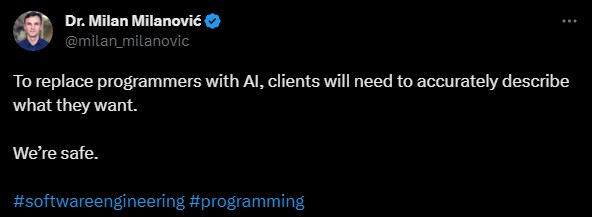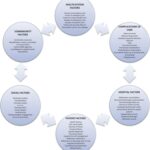In an era dominated by discussions about artificial intelligence, it’s natural to wonder about the future of various professions, including software development. The advancements in AI have sparked concerns about whether machines might soon replace human programmers. While AI’s capabilities are indeed impressive, understanding the nuances of software creation reveals a more nuanced picture for those looking to build a programming career. The truth is, while AI will undoubtedly change the landscape, it also presents new opportunities and emphasizes the enduring importance of core programming skills and human ingenuity.
For many aspiring programmers, the initial focus is on mastering syntax, logic, and various coding techniques. These are essential building blocks, and while challenging at first, they become more manageable with practice. However, experienced developers understand that the real hurdles in software development often lie beyond writing code itself. The most demanding aspect is not the translation of instructions into code, but rather the interpretation and definition of what the software is actually meant to achieve. This is where the human element becomes indispensable, and where a successful programming career truly takes shape.
The Critical Role of Requirements in Software Development
Early career experiences often highlight the gap between technical coding and the crucial process of requirement gathering and interpretation. Imagine a scenario where a seemingly minor oversight in understanding client needs leads to significant rework and potential project delays. This isn’t just a hypothetical situation; it’s a common learning curve for many in the field.
Consider a project focused on developing software for configuring custom products for e-commerce platforms. A junior developer, tasked with generating dynamic terms and conditions, might identify a potential ‘defect’ – a user could override default terms that should be fixed based on product type and location. Upon raising this concern, the developer might be met with reassurance from a senior executive that such an override “will never happen.” This dismissal, based on assumed user behavior and business process understanding, could lead the developer to shrug off the concern.
 Software development lifecycle highlighting requirements gathering
Software development lifecycle highlighting requirements gathering
However, months later, just before launch, a tester might discover this exact ‘defect’ – the user is indeed able to override the intended terms. This scenario, while seemingly simple, underscores a fundamental truth: the challenge isn’t always in the code itself, but in accurately anticipating user behavior and translating business needs into precise software requirements. Countless software engineers share similar stories, where the root cause of problems isn’t coding errors, but rather unclear, inconsistent, or simply incorrect initial requirements. As you build your programming career, understanding and mastering the art of requirements elicitation and analysis becomes as crucial as your coding skills.
AI’s Current Capabilities: Chess vs. Self-Driving Cars and Career Implications
To understand AI’s current role and its impact on a programming career, it’s helpful to compare its successes and limitations in different domains. AI has achieved remarkable success in areas like chess. Chess is a game with finite parameters, clearly defined rules, and a singular objective: checkmate. AI excels in this environment because it can analyze vast numbers of potential moves and calculate the optimal strategy within these fixed constraints. In essence, chess for AI is a well-defined rules engine.
However, when we look at more complex, real-world applications, like self-driving cars, the picture changes. While significant progress has been made, truly autonomous self-driving cars are still not widely available. Like chess AI, self-driving systems rely on rules-based engines. But unlike chess, the rules for navigating every possible driving situation are not finite or clearly defined. Driving involves countless variables and requires constant judgment calls – navigating unpredictable traffic, reacting to pedestrians, and adapting to unexpected road conditions. These situations are not easily codified into a fixed set of rules.
This comparison is crucial for understanding a programming career in the age of AI. Software development, much like driving, is far more complex and variable-rich than chess. It involves navigating ambiguity, adapting to changing requirements, and making judgment calls in situations that are rarely black and white. While AI can excel in tasks with clearly defined rules and finite parameters, it currently struggles with the messy, ambiguous, and ever-evolving nature of real-world software development requirements. This highlights the enduring value of human skills in critical thinking, problem-solving, and adaptability – skills essential for a thriving programming career.
Beyond Code: Software as a Human-Driven Endeavor
Creating and maintaining software is more akin to navigating the complexities of driving than playing a game of chess. Software is rarely a static entity; it evolves, adapts, and grows over time. Features are added, bugs are fixed, and user needs change. This dynamic nature contrasts sharply with the finite nature of a chess game, which ends once a winner is declared.
In software development, we strive to bring some structure to this inherent complexity through tools like technical specifications. At their best, technical specs aim to define user behaviors and program flows in detail – “when a user clicks this button, this data structure is created, and this service is invoked.” However, the reality is often less structured. Developers frequently work with wishlists, napkin sketches, and vaguely defined requirements documents, tasked with filling in the gaps and making crucial judgments.
Furthermore, requirements are not always fixed; they change and evolve throughout the development process. Consider a project aimed at creating a survey application via SMS to gather health information during a crisis. Initially, the concept might seem straightforward. However, upon closer examination, the complexities emerge. Designing a multi-step SMS survey with multiple-choice questions about sensitive health symptoms requires careful consideration of potential errors, invalid inputs, and data handling. Simply coding the survey mechanism is insufficient; understanding the nuances of data collection, user interaction in a limited medium like SMS, and potential points of failure is paramount.
This example underscores that building a successful programming career isn’t solely about writing code. It’s about understanding user needs, anticipating problems, and making informed decisions in the face of ambiguity. It’s about critical thinking, problem-solving, and effective communication – skills that are fundamentally human and highly valued in the tech industry.
Agile, AI, and the Future of Programming Careers
The software industry’s shift from waterfall to agile methodologies further emphasizes the importance of flexibility and adaptability in software development. The waterfall approach, with its emphasis on upfront, detailed planning, often faltered because stakeholders struggled to fully define and anticipate all requirements at the outset. Agile methodologies emerged as a response, embracing iterative development, continuous feedback, and the ability to adapt to evolving needs.
AI’s role in this evolving landscape is likely to be in augmenting, rather than replacing, human programmers. AI excels at code generation, automation, and repetitive tasks. It can potentially accelerate the coding process, especially for well-defined components or rewriting existing codebases for modern platforms like transitioning legacy COBOL systems. However, AI currently lacks the human capacity for nuanced understanding, complex problem decomposition, and effective communication needed to navigate ambiguous requirements and evolving project goals.
Therefore, building a future-proof programming career means focusing on developing skills that complement AI’s strengths and address its limitations. These skills include:
- Requirements Engineering: Mastering the art of eliciting, analyzing, and documenting clear and comprehensive software requirements.
- Problem-Solving and Critical Thinking: Developing the ability to break down complex problems, identify root causes, and devise effective solutions.
- Communication and Collaboration: Honing communication skills to effectively interact with stakeholders, understand their needs, and collaborate with team members.
- Domain Expertise: Gaining knowledge in specific industries or domains to better understand user needs and business contexts.
- Adaptability and Continuous Learning: Embracing change, staying updated with new technologies, and continuously learning and adapting your skills.
In conclusion, while AI will undoubtedly transform aspects of software development, it is unlikely to replace human programmers entirely, especially in roles that require creativity, critical thinking, and nuanced understanding of complex requirements. Building a successful programming career in the age of AI means focusing on developing these uniquely human skills. By mastering the art of understanding and defining problems, communicating effectively, and continuously adapting, you can not only thrive in the evolving tech landscape but also leverage AI as a powerful tool to enhance your capabilities and build a rewarding and future-proof programming career.
